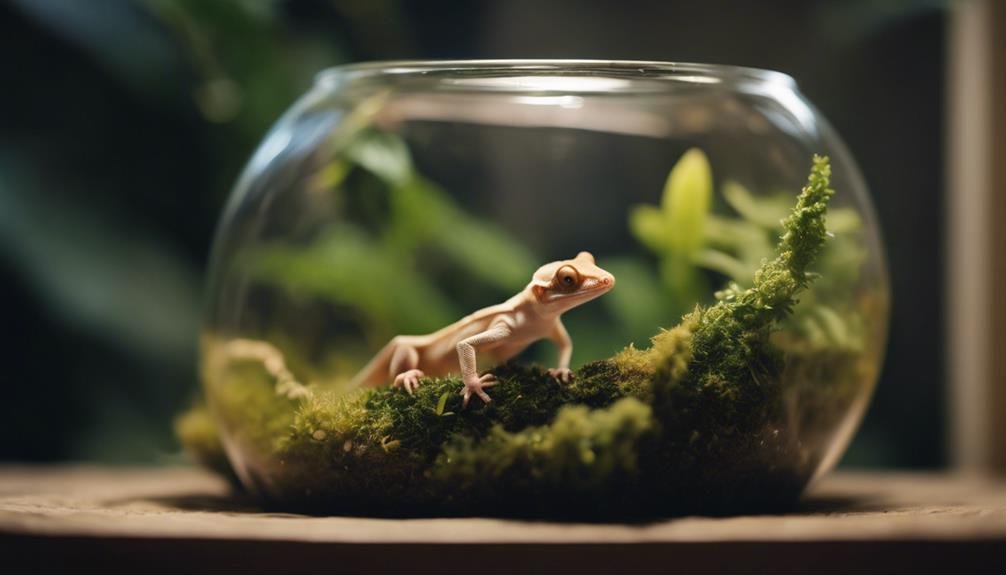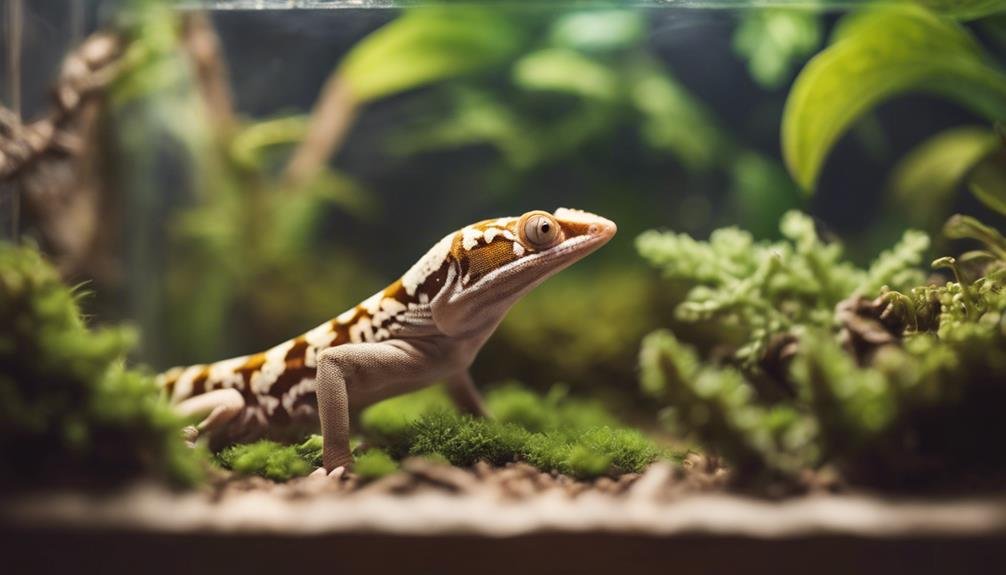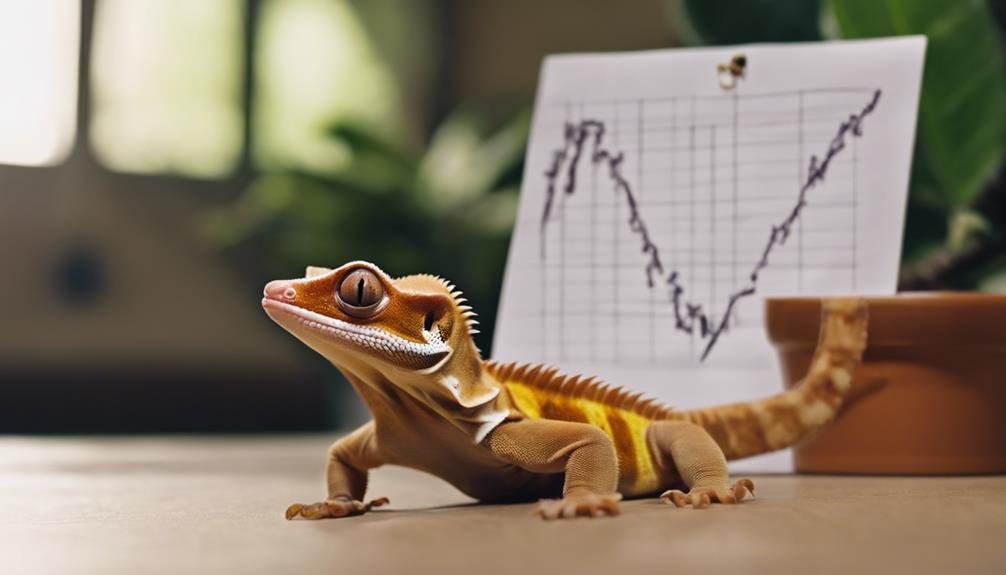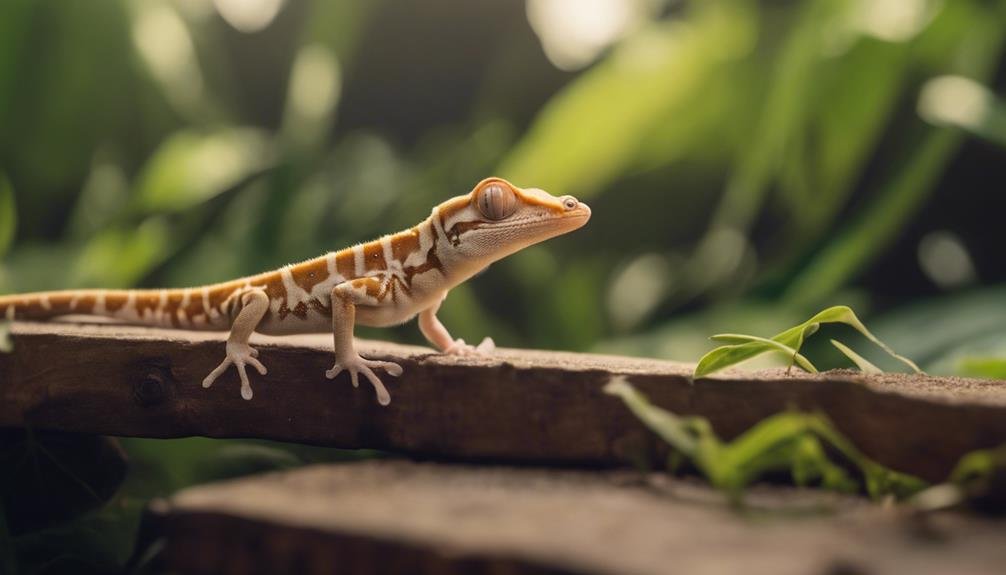If you’re considering adding a crested gecko to your family or you’ve already taken the plunge, you’re likely curious about how big they’ll get. Knowing their potential size, from a modest 5.9 inches to a more robust 9.8 inches, is vital for planning their habitat and care. While males generally outsize females, factors like genetics and diet play a significant role in their growth. However, there’s more to understand about their size than just numbers. The nuances of their development and how it influences their living conditions are essential for their well-being. Let’s explore what makes their size such an important aspect of their care, and why a one-size-fits-all approach doesn’t work.
Key Takeaways
- Crested Geckos typically grow to a length of 5.9 to 9.8 inches.
- Adult Crested Geckos weigh around 1.2 to 1.9 ounces.
- Males generally grow larger than females, influenced by genetics and diet.
- Lifespan ranges from 5 to 20 years, with notable growth from hatchling to adulthood.
- Proper care, including a varied diet and suitable habitat, is crucial for optimal growth.
Crested Gecko Size Overview
Understanding the size of crested geckos, they typically grow between 5.9 to 9.8 inches in length, ensuring you know what to expect as they mature. Crested geckos, known for their unique eyelash-like crests, demonstrate a notable growth rate from hatchling to adulthood. Observing their development, it’s fascinating how these creatures transform, starting from a minuscule size at birth to reaching their full potential.
In the wild, crested geckos navigate through dense foliage, their size playing a significant role in their survival. Their compact body width, ranging from 0.79 to 1.34 inches, and a body height of 0.67 to 1.06 inches, allow them to adeptly maneuver through their environment. This agility aids in avoiding predators and hunting for food, underscoring the importance of their physical dimensions.
Adult crested geckos tip the scales at around 1.2 to 1.9 ounces, a reflection of their hearty nature despite their seemingly delicate appearance. Their lifespan, averaging between 5 to 20 years, further highlights how their size contributes to their overall well-being and longevity in both captive and wild settings. Understanding these aspects offers a thorough view of what to expect as your crested gecko grows, ensuring a well-prepared environment for their thriving.
Male Vs Female Growth Patterns
When contemplating the growth patterns of crested geckos, it’s vital to bear in mind that males typically outsize their female counterparts, reaching lengths of 8-10 inches. This size difference isn’t just a number; it reflects on the unique needs and care each gender may require. Understanding the male vs female growth patterns is key to ensuring your pet thrives.
Here are four critical points to take into account:
- Size Disparity: Male crested geckos generally grow larger than females, with a noticeable difference in adult sizes. Males can reach up to 10 inches, while females usually max out at around 7-8 inches.
- Growth Influences: Various factors, including genetics and diet, play significant roles in how your crested gecko grows. This means that not all geckos will fit the typical size range perfectly.
- Monitoring Growth: Keeping a close eye on your gecko’s growth can help you adjust care as needed. Monitoring is crucial for detecting any health issues early on.
- Expect Variations: Even within the same gender, individual growth patterns can vary. It’s vital to understand that each crested gecko is unique.
Hatchling Terrarium Needs


When setting up your hatchling crested gecko’s home, you’ll need to take into account the right terrarium size, habitat decor, and the best temperature and humidity.
A well-sized enclosure guarantees they don’t feel lost or insecure, while the right decor provides necessary climbing and hiding spots.
Keeping the temperature and humidity within the ideal range is essential for their health and growth.
Suitable Terrarium Size
For your hatchling crested gecko, a terrarium measuring 12L x 12W x 12H inches offers an ideal habitat to support their early growth and comfort. This compact size not only provides a sense of security for your little gecko but also makes it easier for them to acclimate and grow.
To support their well-being, here’s what you need to include:
- Adequate Ventilation: Ensures fresh air while maintaining humidity.
- Hiding Spots: Offers security and stress relief for your gecko.
- UVB Lighting: Essential for their health, simulating natural sunlight.
- Food and Water Areas: Must be easily accessible to support their dietary needs.
Keeping an eye on your hatchling’s behavior and growth within this Crested Gecko Terrarium setup is essential for their development.
Essential Habitat Decor
Beyond selecting the right size terrarium for your hatchling crested gecko, incorporating the appropriate habitat decor greatly enhances their living environment. Keep in mind, while your pet reptile is still small, the right decor not only makes the terrarium visually appealing but also supports their natural behaviors.
By choosing a 12L x 12W x 12H terrarium, you’re providing a cozy and secure space. However, it’s important to fill it with decor that encourages exploration and exercise. This includes adding climbing structures, hiding spots, and foliage that mimic their natural habitat. These elements are vital for their development, helping them to easily locate food and water while feeling safe.
Proper decor setup ensures your hatchling thrives, promoting a sense of security and stimulating their instinctual behaviors.
Optimal Temperature and Humidity
Maintaining the right balance of temperature and humidity in your hatchling’s terrarium is essential for their health and growth. To make sure you’re on the right track, follow these simple steps:
- Keep daytime temperatures between 72-80°F. This range ensures your gecko stays active and healthy.
- Allow nighttime temperatures to drop to 65-75°F. A cooler environment mimics their natural habitat, promoting good sleep cycles.
- Maintain humidity levels at 60-80%. This is vital for their hydration and skin health.
- Use a digital hygrometer to monitor humidity levels. It’s the best way to make sure the terrarium conditions remain ideal for your hatchling’s well-being.
Juvenile and Adult Enclosures


As your crested gecko grows, you’ll need to upgrade its home to make certain it has enough space to thrive. For juveniles and adults, an enclosure measuring 18L x 18W x 36H provides the vertical height they love, along with ample room for exploring.
We’ll guide you through selecting the perfect habitat and setting it up to mimic their natural environment, focusing on the ideal enclosure size and habitat setup tips.
Optimal Enclosure Size
When selecting an enclosure for your crested gecko, it’s important to consider their size, with juveniles and adults both thriving in an 18L x 18W x 36H space. This size supports their growth patterns, meets the space requirements, and fits the recommended enclosure dimensions, ensuring they’ve enough room to climb and explore.
Here are four key points to remember:
- Growth Patterns – Understanding how your gecko grows helps in providing a lasting home.
- Enclosure Dimensions – An 18L x 18W x 36H enclosure accommodates both juveniles and adults.
- Space Requirements – This size meets their need for vertical and horizontal movement.
- Arboreal Nature – Their love for climbing is why taller enclosures are essential.
Habitat Setup Tips
After understanding the ideal enclosure size, let’s explore how to effectively set up habitats for both juvenile and adult crested geckos.
| Habitat Feature | Importance |
|---|---|
| Climbing Accessories | Essential for exercise and mimicking natural arboreal environments. |
| Branch Placement | Provides necessary structure for climbing and resting. |
| Elevated Hides | Offers security and stress relief by simulating natural hiding spots. |
| Vertical Space Utilization | Vital for arboreal species to thrive, ensuring enough room to climb. |
| Horizontal Layout | Important for simulating natural behavior and encouraging exploration.
Incorporating these features in your crested gecko’s habitat will ensure they have a comfortable, stimulating environment that closely mimics their natural surroundings, promoting healthy behaviors and growth.
Importance of Vertical Space
Understanding the importance of vertical space in a crested gecko’s terrarium is essential for their well-being. Crested geckos naturally thrive in an environment that allows them to climb and explore, mimicking their arboreal habitat in the wild. Providing a terrarium with ample vertical space guarantees that your crested gecko can engage in these natural behaviors, which is critical for their physical and mental health.
Here’s why vertical space is so significant:
- Climbing enrichment – Vertical space offers essential climbing opportunities, allowing cresties to exercise and stay active. This helps prevent boredom and stress, contributing to a happier, healthier gecko.
- Vertical hideouts – Including vertical hideouts in your terrarium design gives your gecko secure places to rest and feel safe, which is essential for their well-being.
- Branch placement – Strategically placing branches not only aids in climbing but also in exploring the terrarium. This setup encourages natural behaviors and provides a more stimulating environment.
- Preventing health issues – Adequate vertical space promotes regular activity, which can help fend off potential health problems caused by inactivity, such as obesity or muscle atrophy.
Cohabitation Considerations


Before you contemplate housing multiple crested geckos together, it is crucial to understand the specific needs and potential risks involved to guarantee their harmony and well-being. The cohabitation of crested geckos demands a keen eye on their behavioral dynamics, social interactions, and territorial behavior to ensure a peaceful environment.
| Cohabitation Setup | Considerations | Recommendations |
|---|---|---|
| Multiple Males | High risk of aggression | Avoid completely |
| Male with Females | Potential for stress and competition | Supervise closely; provide ample space |
| Multiple Females | Risk of territorial disputes | Introduce simultaneously; ensure large enclosure |
Avoid housing multiple male crested geckos together due to the high risk of fights and aggression, which can lead to injuries. While it is possible to house one male with one or more females, careful supervision is necessary to watch for any negative interactions. If you’re considering housing two or more females together, doing so from the start can help reduce territorial behavior. Additionally, providing an enclosure of at least 23,000 cubic inches and ensuring multiple hiding spots and feeding stations can minimize competition and stress, fostering more harmonious social interactions among your crested geckos.
Enclosure Size for Multiple Geckos
Selecting the right enclosure size is crucial when planning to house multiple crested geckos together, guaranteeing they’ve enough space to thrive without stress or competition. Understanding geckos’ behavior, enclosure layout, and group dynamics plays an important role in creating a harmonious environment.
Here’s what you need to take into account:
- Avoid Male Rivalry: Never house multiple males together due to their territorial nature. One male with multiple females can work, but keep an eye on their interactions to prevent stress.
- Female Group Dynamics: Introducing two or more females at the same time can ease territorial disputes. For two females, aim for an enclosure of at least 23,000 cubic inches.
- Enclosure Layout Matters: Design the enclosure with multiple hiding spots and feeding stations. This layout minimizes competition and potential injuries, catering to the geckos’ natural behaviors and preferences.
- Monitor and Adjust: Even with careful planning, watch your geckos’ behavior closely. Adjustments might be necessary to maintain peace and ensure all geckos are thriving.
Signs of Growth Stagnation


If your gecko isn’t gaining weight despite regular feedings, it might be showing signs of growth stagnation. This lack of progress, especially over an extended period, is a clear indicator that something’s not right. Identifying the causes early on is key to tackling this issue effectively.
Stunted growth isn’t just about what you’re feeding them; it could also stem from inadequate environmental conditions, stress, illness, or even genetic factors. That’s where growth monitoring becomes invaluable. By keeping a close eye on their development, you’ll be better equipped to spot any deviations from their normal growth patterns.
Don’t underestimate the importance of a veterinary consultation in these situations. If you’ve noticed persistent signs of growth stagnation, seeking professional advice is essential. A vet can conduct a thorough examination to pinpoint the specific reasons behind the stagnation, whether it’s an underlying health issue or something related to their care.
Impact of Diet on Size
Recognizing signs of growth stagnation highlights the significance of examining another key factor: the impact of your crested gecko’s diet on its size. The diet directly affects their growth rate and final size, making dietary influence on size development a key area of focus. Here’s how you can guarantee your crested gecko reaches its full growth potential:
- Offer a Varied Diet: Including insects, fruits, and commercial crested gecko diet (CGD) promotes healthy growth. This variety ensures they’re getting all the necessary nutrients.
- Understand the Role of CGD: Geckos fed solely on CGD may grow at a slower rate. Adding insects to the mix can foster better growth comparison.
- Balance is Key: A balanced diet rich in nutrients is essential for optimal size development. This means not just focusing on one type of food but providing a mix that covers all nutritional bases.
- Manage the Diet Properly: Proper diet management plays an important role. This involves not just what you feed them, but also how much and how often, to make sure they’re not under or overfed.
Monitoring Health and Growth
How can you guarantee your crested gecko remains healthy and continues to grow properly? Monitoring their health and growth is essential, and one of the best methods is by regularly tracking their weight. Weight gain is an important health indicator and a clear sign of proper development. By keeping a consistent weight tracking schedule, you’ll spot any abnormalities in their growth patterns early on. This proactive approach allows you to make timely adjustments in their diet and care, ensuring they’re always on the right path.
Understanding growth milestones is key. Consulting a crested gecko weight chart helps you assess if your pet is hitting these important markers. If they’re under or overweight, it’s a signal to review and possibly change their diet or care routine. The benefits of weight tracking go beyond just monitoring growth; it’s a window into the overall well-being of your gecko.
Does Dehydration Affect the Growth and Size of Crested Geckos?
Crested geckos are prone to dehydration, which can affect their growth and size. Preventing crestie dehydration treatments include keeping their enclosure humid, providing a shallow water dish, and misting the tank regularly. Adequate hydration is essential for the overall health and well-being of these unique reptiles.
Frequently Asked Questions
How Big Will My Crested Gecko Get?
Your crested gecko’s final size largely depends on its growth rate, diet influence, and genetic factors. Typically, they’ll reach between 6-10 inches in length. However, some might grow slightly larger or smaller.
Males often end up bigger than females. By ensuring a nutritious diet and ideal habitat conditions, you’ll support their growth.
Is a 12x12x18 Big Enough for a Crested Gecko?
Yes, a 12x12x18 terrarium is big enough for a hatchling or juvenile crested gecko, giving them plenty of room to climb, which is important considering their need for vertical space.
It’s also great for maintaining proper humidity levels and ensuring adequate ventilation, essential for their health.
However, as your gecko grows, you’ll need to think about a larger enclosure to keep them comfortable and happy in their arboreal setup.
Is a 20 Gallon Tank Big Enough for a Crested Gecko?
Yes, a 20-gallon tank is definitely important enough for a crested gecko. It’s essential to choose the right tank materials to guarantee durability and safety.
You’ll also need to manage the lighting needs carefully to mimic their natural environment and promote a healthy day-night cycle.
Don’t forget about humidity control; maintaining the proper levels is crucial for their well-being.
This setup provides an ideal space for climbing and exploring, keeping your gecko happy and healthy.
What Size Setup for Crested Gecko?
You’ll need a setup that supports your crested gecko’s growth and arboreal lifestyle.
Start with a 12L x 12W x 12H terrarium for hatchlings, then upgrade to an 18L x 18W x 36H for adults. Make sure it’s equipped with proper lighting options, maintains a consistent feeding schedule, and has humidity control to mimic their natural environment.
This setup not only accommodates their size but also encourages natural behavior and healthy development.
Conclusion
To sum up, your crested gecko’s size varies, with males generally outgrowing females. From hatchling to adult, their habitat needs evolve, requiring more space and verticality.
Housing multiple geckos demands even larger enclosures. Watch out for growth stagnation signs—it’s often a diet or health issue. Regular monitoring guarantees they’re thriving.
Remember, understanding their size and growth patterns is key to providing the best care for these unique reptiles, guaranteeing their health and happiness in your care.


